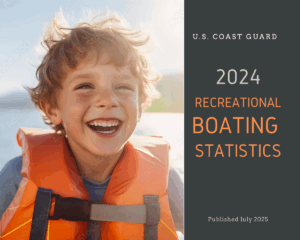
A boating emergency can happen anytime, anywhere — and does not only refer to a problem with the vessel, but also to any dangerous situation involving a passenger. It is key for a boater to remain aware of the situation and assess their risk before leaving shore and during the trip:
Before leaving shore:
- Prepare the boat by scheduling a vessel safety check prior to the boating season with local U.S. Coast Guard Auxiliary or U.S. Power Squadrons.
- Know the latest marine weather forecast prior to going out, and keep a regular check for changing conditions.
- File a float plan with someone trusted back on dry land that includes details about the trip, boat, passengers, towing or trailer vehicle, communication equipment, and emergency contacts. Find out more at floatplancentral.org.
- Know the boat’s capacity. If there are more passengers on the boat than it was designed to handle, the boat may become unstable and capsize.
During the trip:
- Make sure everyone – even experienced swimmers – wears a properly fitting U.S. Coast Guard-approved life jacket appropriate for the water activity.
- Follow navigation rules, such as maintaining a proper lookout and safe speed.
- Never boat under the influence. Alcohol is responsible for 23 percent of boating fatalities.
- Keep in touch. Satellite phones, emergency position indicating radio beacons (EPIRB), VHF-DSC (digital selective calling) marine radios and personal locator beacons can all contribute in an emergency.
- Don’t panic if the boat operator or a passenger falls into the water. They must remember to stay afloat with the help of their life jacket, regain control of their breathing, keep their head above water in vision of rescuers, and stay with the boat if possible.
More Information



